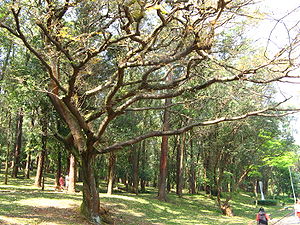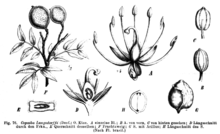Copaifera langsdorffii
| Copaifera langsdorffii | ||||||||||||
|---|---|---|---|---|---|---|---|---|---|---|---|---|

Copaifera langsdorfii in a park in São Paulo, Brazil |
||||||||||||
| Systematics | ||||||||||||
|
||||||||||||
| Scientific name | ||||||||||||
| Copaifera langsdorffii | ||||||||||||
| Desf. |
Copaifera langsdorffii is a flowering plant in the subfamily of caesalpinioideae (Caesalpinioideae) within the family of the Leguminosae (Fabaceae). This tree , which isnative tothe Brazilian rainforest , from Bolivia to Argentina and Paraguay , also known as the Diesel tree , is considered a plant species for the production of renewable fuels.
description
Vegetative characteristics
Copaifera langsdorffii grows as an evergreen tree with a spreading crown, the stature heights of 15 to 35 meters and a trunk diameter of about 0.8–1 and less often up to 4 meters. Sometimes it is only dwarfed in the savannah and only 1–2 meters high. The dark brown bark is rough and cracked to scaly. The tree carries a copaiva balm .
The alternately arranged leaves are 5 to 12 inches long and divided into petioles and leaf blades. The pairs feathery leaf blade contains two to five pairs more or less alternate, underside lighter, slightly leathery pinna leaflet . The short-stalked, entire-margined, mostly rounded to rounded-pointed, rarely pointed to pointed, as well as ovate to elliptical or obovate leaflets are 2 to 6 centimeters long, 1.2 to 2.5 centimeters wide and dotted with glands. The nerve is pinnate with a lighter central vein. The young leaves are reddish.
Generative characteristics
Many flowers stand together in terminal racemose or compound panicle inflorescences . The short-stalked, hermaphrodite flowers with a simple flower cover are whitish. The four concave sepals are hairless on the outside and downy hairy on the inside, the petals are missing. The rarely eight to, usually ten stamens are free. There is only one carpel . The upper and hairy ovary is short-stalked and underlaid by a discus . The stylus with a small, heady scar is often bent.
Small, yellow to dark red, oily and pointed, ellipsoidal legumes are formed, which then dry out, flatten out and become leathery, brown, they are almost round, elliptical to ovoid and 2.3 to 3.3 centimeters in size and usually only contain a seed. The large, black, ellipsoidal and about 1.3-1.8 centimeters large, smooth seeds are partially covered by a large, orange to reddish aril .
Systematics
The first description was in 1821 by René Louiche Desfontaines in Mém. Mus. Hist. Nat. 7: 877. Various synonyms are known.
There are three known varieties:
- Copaifera langsdorffii var. Glabra (Vogel) Benth.
- Copaifera langsdorffii var. Grandifolia Benth.
- Copaifera langsdorffii var. Laxa (Hayne) Benth.
Use as fuel
The wood is relatively light because of its porosity. The pores of the wood are filled with oleoresins . For tapping, a hole is cut in the wood, in which the oleoresin collects and can be taken up there. Only about 1–2 liters are produced per tree per year !, earlier, much higher figures were out of thin air. The storage stability of the fuels obtained in this way is described as poor.
The Copaifera langsdorffii grows only slowly outside the tropics and is sensitive. The first plantations have been set up in Australia . The wood is mostly burned.
literature
- Jean H. Langenheim: Plant resins: chemistry, evolution, ecology, and ethnobotany. Timber Press, 2003, ISBN 0-88192-574-8 , limited preview in Google Book Search.
- James A. Duke, Judith L. DuCellier: CRC handbook of alternative cash crops. CRC Press, 1993, ISBN 0-8493-3620-1 , pp. 192-196, limited preview in Google Book Search.
- W. Blaschek, R. Hänsel among others: Hager's Handbook of Pharmaceutical Practice. Volume 2: Drugs A – K , Springer, 1998, ISBN 3-540-61618-7 , pp. 421–428 limited preview in the Google book search.
Web links
- Copeifera langsdorfii at Useful Tropical Plants.
- HG Richter, MJ Dallwitz: Copaifera langsdorfii in commercial timber from DELTA .
- Data sheet from the Center for New Crops & Plant Products at Purdue University .
- Datasheet at AgroForestryTree Database (PDF).
- Diesel tree (PDF), at Department of Agriculture and Fisheries, Queensland.
- Copaifera langsdorffii from Árvores do Bioma Cerrado, accessed on October 20, 2019.
Individual evidence
- ↑ Biofuel: Where diesel grows on trees - climate and energy - FOCUS Online . focus.de. Retrieved October 29, 2009.
- ^ Copaifera langsdorffii at KEW Science.



